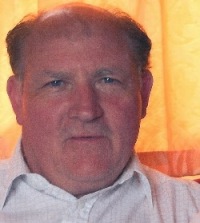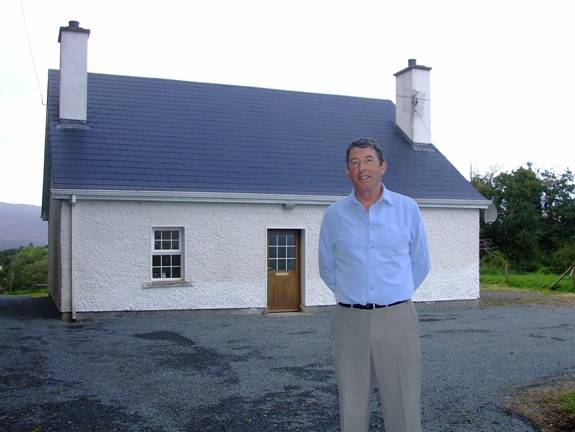 Irish Eyes
Irish Eyes
By
Mattie Lennon
From Mcgettigan’s Field To Gaelic
Park
“My bother was telling me how one lovely Sunday morning
he was taking a stroll outside San Francisco on the edge
of the Pacific, when he saw, hurrying with little bundles
under their oxters, men of rural Irish complex. Sometime
later he came on a Gaelic football match in progress.
Everything was as at home . . . not a man of them had
ever left home and the mysterious Pacific was just a
bog-hole gurgling with eels and frogs. Yet there was
something queer and wonderful about the sight . . . or
the thought” (Patrick Kavanagh)
Kavanagh was no great shakes as a goalie for Enniskeen
Grattens and he even went so far as to argue that since
Joyce only mentioned sport once in Ulysses it couldn’t be
very important. Yet he acknowledged that it was wonderful
when Irish men brought their Gaelic games across the
world. And they are doing it still.
In his memoir John Cassidy tells us,
“Like most young people growing up in Donegal in the
early nineteen sixties, I dreamt of one day playing for
my county in an All Ireland Football Final in Croke Park.
I quickly realised, however, that I had neither the
natural ability nor necessary talent for that dream to
become a reality. But that did not stop me dreaming.
"My introduction to Croke Park began when I was
about six years old. My late father would always listen
to the games on the radio: the wireless as it was known
then. Each week he would bring the wet battery into
Donegal town and have it re-charged.
"Electricity arrived in rural Donegal in 1959/60. Our
wireless was used sparingly i.e. news bulletins and a few
other important programmes which included the big matches
in Croke Park.
"As every house did not have a wireless many of our
neighbours’ children would gather in our kitchen and
listen to the late, great, Michael O ‘Heir as he gave a
blow by blow account of games one hundred and fifty miles
away.
"Once the match was over we would assemble in
McGettigan’s field and replay the game. Two older boys
would select the opposing teams: every one present was
included which meant we often played twenty a side. As
our pitch consisted of the entire field this was no
problem.
With the goalposts (four jackets) in place the game would
begin. It would end for one of the following reasons:
Hunger, darkness or a pitch invasion by McGettigan’s
cattle.”
”

John Cassidy, facing the rising sun and
Barnasmore Gap, at home in Clougher.
John Cassidy knew from an early age that Gaelic
football was the preserve of (for the most part, poor)
Irish Catholics. Didn't his fellow Ulsterman,
author/journalist, Cormac MacConnell confess to altering
the "Mc" on his birth certificate in order to show that
he was born into the kind of "starving Papish family that
plays Gaelic football rather than the wealthy
Presbyterians of that era who played rugby.
Four decades later, in Dublin, while working as a
supervisor with Dublin Bus, John recalled the words of
that great American reformer and political activist
W.E.B. Du Bois, who said: "The problem of the
twentieth century is the problem of the colour line- the
relation of the darker to the lighter races of men in
Asia and Africa, in America and the islands of the
sea".
Dublin Bus, employs a workforce taken from more than
50 countries and when it comes to raising multicultural
awareness, not only among his colleagues but worldwide,
there is none more innovative than John Cassidy. He came
up with a unique idea, took it to his bosses in Dublin
bus and got 100% support. Drivers, Supervisors,
Divisional Managers et al did all in their power
to ensure that the Donegalman's dream would become a
reality. Thanks to the overwhelming support and John's
foresight, tenacity, drive, Ulster cunning and cohesion
thirty Gaelic players lined out on the Dublin Bus pitch
at Coldcut in west Dublin at three o 'clock,on Thursday
06th November 2004. But this was to be a game with a
difference. REFEREE, TOM KITT, WAS THE ONLY IRISHMAN
ON THAT FIELD!
John’s interest in the native sports did get him to
Croke Park . . .as a voluntary senior steward. And while
engaged in this capacity at the All-Ireland football
final of 2005 his mobile phone rang. A man with a North
American accent, purporting to represent the New York
Police Department Gaelic Football Club asked John if he
could field a team to play them in Gaelic Park, New York.
John was busy. Micheal Muircheartaigh was telling the
world that Tyrone was beating Kerry while at the same
time giving the pedigree of a centre half-back from
Dingle. There seemed to be a bit of unrest on
Hill-Sixteen.
John said “OK” and promptly hung up. A mixture of
experience and healthy Ulster suspicion told him that
the call was a wind-up. . . but it wasn’t a wind-up. As
the final whistle blew John’s phone rang again. The same
voice re-iterated the request.
Each of the three CIE companies, Dublin Bus, Bus
Eireann and Irish Rail have a Gaelic Football team. And
it was from these after much though, observation and
enquiry that John Cassidy picked his panel of players.
Peter Kearns, former Dublin hurler is Captain and Paul
Curran, All-Ireland medal winner, with Meath, 1991 is
Vice-Captain.
And he didn’t forget Donegal; one of his key-players
is Kevin O’Donnell from Ballybofey while Ciaran McStay,
Ref Of the Year, 2007, will be keeping a sharp eye from
the sideline.
He had a team and the next task was to select a
committee. The committee was formed and it certainly
wouldn’t fall into Fred Allen’s description which
defined a committee as, “a group of men who individually
can do nothing but as a group decide that nothing can be
done.”
Martin Kenny is Chairman.. He is also GAA
Club Chairman and was prime organiser of the first CIE/
Ulsterbus inter-depot competition in 1978. He has given
much valuable advice and assistance during the planning
and organising of this historic trip.
Brendan Malone, who has given forty years to
Gaelic games, and Keith Graham, prominent player and
Meath man, are joint secretaries.
Mick Feterston, from Roscommon, was a key player
on Clontarf hurling and football teams for many years
is Psysio.
Tom Kitt, member of a well-known Political
dynasty, referee and ardent supporter of Galway football
and Damian Donovan, a loyal Dublin supporter, are joint
treasurers.
Tony Doran, (retired) along with Chris Conway (Bus
Eireann Inspector) forged strong and lasting links with
the Police and Fire departments in New York when they
organized a trip to Ireland for members of the New York
Police and Fire Departments after 9/11. They were
instrumental in having a lasting memorial erected to the
victims of 9/11, in Donadee.
John Leonard, Chief Steward from Croke Park, is
GAA Liaison Officer.
John Cassidy, the man who started it all, is
Public Relations Officer. He can be contacted at:
johncassidy92@yahoo.com
Kevin Fitzpatrick, CIE Sports and Social Officer,
gave the committee the full benefit of his experience of
fundraising.
Uncle Sam will witness the result when a planeload
of players and supporters touch down at “Kennedy” on 15th
October. During the following weekend they will play
teams from the NYPD and FDNY.
Billy Nolan, of The Emerald Society FDNY, told
me:
“We here are very happy to have the CIE Football team
here in October. Over the past 7 years we have had the
Dublin Fire Brigade visit NYC. Mostly on the even years
('02,'04,'06,) they would come out to us and we in turn
would travel to Dublin to play them. We do play for The
Lord Mayor's Trophy.
So we will be ready for the CIE Lads, come October.
As of yet, we do not have any spy flim (as the N.E.
Patriots) on their club, but we will be ready. Just like
the N.Y. Giants. We hope to show everyone a great time
here in New York, win or lose”.
Francis M. Cornfard said that nothing should ever
be done for the first time. Well “first” is John
Cassidy’s middle name. The “multi-culture” match in
Coldcut in 2004 was a definite first and on Saturday 2nd
February last he brought his team to Omagh to meet a team
from Ulster bus at Tattireagh/ Saint Patrick’s ground.
It was the first time a CIE team had played north of the
border. And when they grace the turf of Gaelic Park it
will the first time a CIE team played in America.
Gaelic Park has a chequered and interesting history.
It was purchased by the GAA in 1926. It was then called
Innisfail Park. After ten years it was forced into
bankruptcy and the city took over the land.
Enter John “Kerry “ O’ Donnell a native of Camp in
West Kerry. His daughter Kerry told the following story
to Weeshie Fogarty of Radio Kerry, “Paddy Grimes and
Billy Snow had the lease of the ground until 1941. They
were not interested in renewing so my father and another
man arranged to meet the solicitor to sign the agreement
and save the grounds from falling into the hands of other
sports or developers. My father was the only one to turn
up on the day of the meeting. Dad decided to go on his
own, it was a massive gamble.
He sold some of his properties, kept thee Eight
Avenue premises and with the help of family and friends
he then ran the grounds. He had this huge fear that the
place would be lost to the GAA and this was the only
reason he decided to step in and thankfully it all worked
out very well for him”. The O’Donnell family is still
involved in Gaelic Park. Manhattan College took it over
in 1991 and in 2007 artificial turf was laid.
Dublin Bus Chief Executive Joe Meaghar said: "
As a Kilkenny man, I am a staunch supporter of GAA I
was very proud to play for Donnybrook and Dublin Bus in
the Inter Depot and Inter Firms competitions in the 80s.
It is great to see a revival of Gaelic games in Dublin
Bus and CIE and I am delighted that for the first time a
football team will represent us in the newly refurbished
Gaelic Park in New York this October 2008. All
participating can be very proud to represent CIE in these
games and I wish the team every success."
When jerseys are being exchanged and the post-mortem
is getting under way in Gaelic Park on 19th October
,win lose or draw, as John Cassidy stands behind the
fruits of his labour, he’ll be secure in the knowledge
that there is no danger of a pitch-invasion by Mc
Gettigan’s cattle.
Click on author's byline for bio
and list of other works published by Pencil Stubs
Online.
Mattie Lennon personally recommends the following site: Kosy Kennels
|